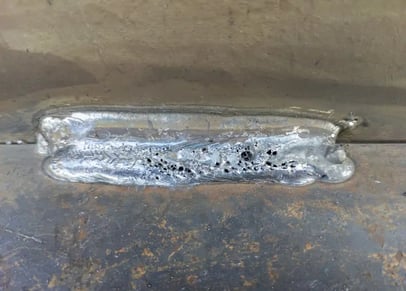Comprehending What is Porosity in Welding: Causes and Solutions
Comprehending What is Porosity in Welding: Causes and Solutions
Blog Article
Unraveling the Secret of Porosity in Welding: Tips for Decreasing Problems and Optimizing Quality
In the intricate world of welding, porosity continues to be a persistent difficulty that can considerably influence the high quality and stability of bonded joints. Recognizing the elements that add to porosity development is crucial in the pursuit of flawless welds. By unwinding the secret of porosity and implementing reliable strategies for defect reduction, welders can elevate the requirements of their job to achieve premium top quality outcomes. As we dig into the midsts of porosity in welding, revealing the keys to its prevention and control will certainly be extremely important for specialists looking for to understand the art of top quality weldments.
Recognizing Porosity in Welding
Porosity in welding, a common issue encountered by welders, describes the existence of gas pockets or spaces in the bonded material, which can jeopardize the honesty and quality of the weld. These gas pockets are generally trapped throughout the welding procedure due to numerous elements such as inappropriate protecting gas, polluted base products, or inaccurate welding criteria. The development of porosity can damage the weld, making it prone to splitting and deterioration, ultimately bring about structural failings.
Comprehending the origin of porosity is vital for welders to efficiently avoid its occurrence. By identifying the value of preserving appropriate gas shielding, making certain the tidiness of base materials, and maximizing welding settings, welders can dramatically lower the chance of porosity formation. In addition, using strategies like preheating the base product, utilizing correct welding techniques, and conducting comprehensive examinations post-welding can better help in decreasing porosity defects. On the whole, a comprehensive understanding of porosity in welding is vital for welders to produce top notch and resilient welds.

Common Causes of Porosity
When inspecting welding procedures for prospective top quality issues, understanding the common reasons of porosity is crucial for preserving weld stability and preventing structural failures. Porosity, characterized by the existence of tooth cavities or spaces in the weld metal, can significantly endanger the mechanical buildings of a bonded joint.
Furthermore, welding at incorrect parameters, such as excessively high traveling rates or currents, can produce excessive disturbance in the weld swimming pool, trapping gases and causing porosity. By addressing these typical reasons through appropriate gas securing, material preparation, and adherence to ideal welding parameters, welders can decrease porosity and boost the quality of their welds.
Methods for Porosity Avoidance
Implementing efficient preventative steps is essential in decreasing the occurrence of porosity in welding processes. One method for porosity avoidance is ensuring appropriate cleansing of the base steel prior to welding. Pollutants such as oil, grease, corrosion, and paint can bring about porosity, so comprehensive cleaning utilizing ideal solvents or mechanical methods is important.

Making use of high-grade filler products and protecting gases that are appropriate for the base metal and welding process can significantly reduce the threat of read more porosity. In addition, keeping appropriate welding parameters, such as voltage, current, take a trip speed, and gas flow price, is vital for porosity prevention.
Furthermore, utilizing correct welding strategies, such as preserving a consistent traveling rate, electrode angle, and arc length, can assist prevent porosity (What is Porosity). Ample training of welders to guarantee they comply with best techniques and quality assurance treatments is likewise vital in lessening porosity issues in welding

Finest Practices for Quality Welds
Making sure adherence to industry standards and correct weld joint preparation are basic facets of accomplishing regularly high-quality welds. In enhancement to these fundamental steps, there are several finest methods that welders can carry out to additionally improve the top quality of their welds. One secret practice is preserving proper cleanliness in the welding area. Contaminants such as oil, grease, rust, and paint can negatively impact my site the quality of the weld, causing issues. Completely cleaning the work surface and surrounding area next page prior to welding can assist alleviate these problems.
Another finest technique is to carefully pick the ideal welding specifications for the certain materials being joined. Proper parameter selection makes sure optimum weld penetration, blend, and general high quality. Using high-quality welding consumables, such as electrodes and filler metals, can considerably impact the final weld high quality.
Value of Porosity Control
Porosity control plays a critical duty in making certain the honesty and top quality of welding joints. Porosity, defined by the existence of cavities or voids within the weld steel, can dramatically jeopardize the mechanical residential properties and architectural stability of the weld. Extreme porosity compromises the weld, making it more prone to fracturing, deterioration, and total failing under operational loads.
Efficient porosity control is vital for keeping the preferred mechanical buildings, such as strength, ductility, and toughness, of the bonded joint. What is Porosity. By minimizing porosity, welders can boost the general quality and reliability of the weld, making certain that it satisfies the efficiency needs of the desired application
Additionally, porosity control is important for achieving the desired aesthetic look of the weld. Extreme porosity not just deteriorates the weld yet also detracts from its visual charm, which can be important in industries where appearances are very important. Appropriate porosity control techniques, such as utilizing the right securing gas, regulating the welding specifications, and guaranteeing correct tidiness of the base materials, are essential for producing top notch welds with very little problems.

Verdict
Finally, porosity in welding is a typical flaw that can endanger the top quality of the weld. By understanding the reasons for porosity and carrying out proper prevention techniques, welders can lessen issues and accomplish better welds. It is important to control porosity in welding to make sure the honesty and toughness of the end product. Carrying out best techniques for porosity control is crucial for achieving optimal welding results.
Report this page